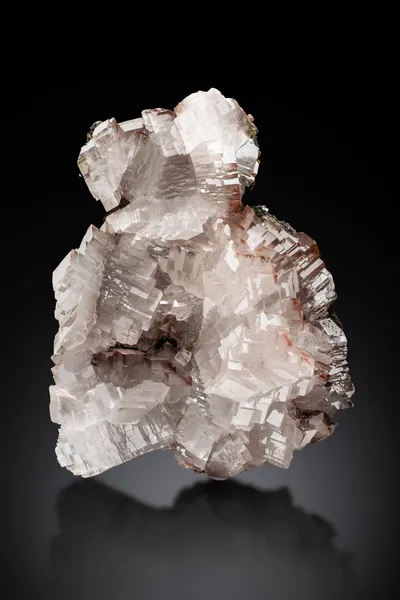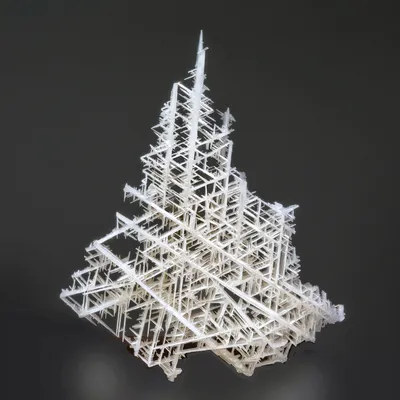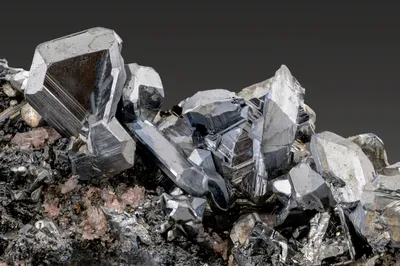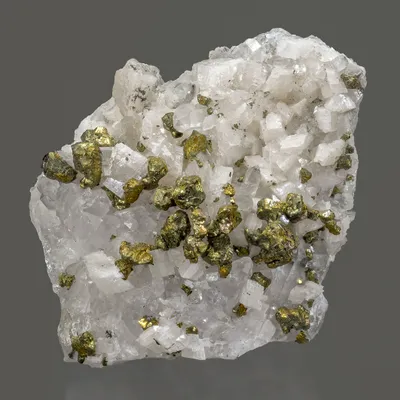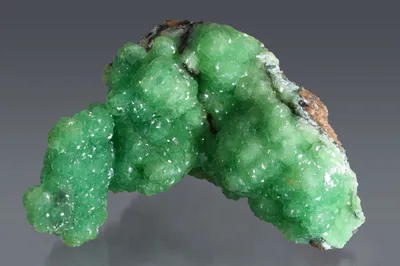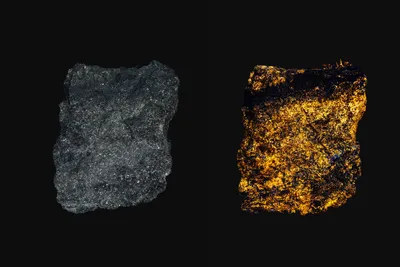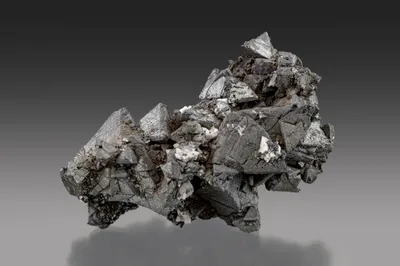
Image Credit: Malcolm Southwood
Mineral Species
Pyrite
Type Locality
No
Composition
FeS2
Crystal System
Cubic
Status at Tsumeb
Confirmed
Abundance
Common
Distribution
First, second and third oxidation zones; sulphide ores; country rocks (kersantite, feldspathic sandstone, dolostone stratigraphy)
Paragenesis
Hypogene; supergene (?); rock-forming (detrital, igneous)
Entry Number
Species; TSNB290
General Notes
By the standards of most polymetallic base metal deposits Tsumeb is iron-deficient. Nevertheless, pyrite is a significant component of the sulphide assemblage although specimen-quality material is by no means abundant.
According to Lombaard et al. (1986) pyrite was a significant constituent of the ore from 5 Level down to 22 Level, locally accounting for approximately 10% of the ore by volume. It was again important from 33 Level downwards and below 38 Level, pyrite accounted for approximately 20 % of the ore by volume.
Pyrite was recorded from the very early years of mining (Maucher 1908a). Moritz (1933) considered pyrite to be the earliest sulphide mineral in the hypogene paragenesis. He observed that its major associates were chalcocite and sphalerite, followed by galena, tennantite and enargite, with germanite as a rare associate. He plotted the abundance (in vol %) of the principal ore and gangue minerals on a level-by-level basis from the surface down to 16 Level and estimated that pyrite accounted for less than 5 % of the ore for most of this interval, but that it increased markedly below 12 Level to reach a little under 10 % by volume on 16 Level.
Klein (1938) mentioned pyrite only in the context of its association with chalcopyrite in the upper levels of the mine.
Botha (1960) noted the presence of up to 5 % pyrite in arenites of the Tschudi Formation that overlie the Otavi Group rocks which host the Tsumeb ore body. Söhnge (1964) recorded the presence of accessory pyrite in the kersantite dykes.
Strunz and Tennyson (1967) commented that pyrite is widespread in the Tsumeb deposit but never in large amounts. They considered that pyrite crystallised at various stages throughout the mineralisation process.
Geier (1973/1974) described iron as a minor metal at Tsumeb and noted that the abundance of pyrite is "… far behind galena, sphalerite and tennantite". Typically, it occurs as anidiomorphic grains in massive sulphide ore and the distribution of pyrite aggregates is somewhat random. Geier suggested that the occasional occurrence of 2-3 cm crystals in cavities represents a younger generation of pyrite. Occasionally, the pyrite contains cobalt; sometimes due to inclusions of linnaeite, but in rare cases the cobalt is in solid solution.
Bartelke (1976) noted that pyrite occurs mainly intergrown with other sulphides in massive ores but that occasionally larger crystals are found in cavities. These larger crystals typically occur as cubes or pentagonal dodecahedrons (pyritohedrons) although he added (citing Schneiderhöhn 1920b) that octahedral faces have also been recorded.
Pinch and Wilson (1977) largely reiterated the descriptions of Moritz (1933) and Geier (1973/1974) but added that crystals of several centimetres have been found.
Otteman (1978) recorded arsenic concentrations of up to 7 wt % in colloform pyrite of supergene origin at Tsumeb.
Keller (1984) described pyrite as "… rare at Tsumeb" but "… occasionally one finds crystals up to 1 cm in size in weathering cavities associated with secondary minerals. The pyrite crystals are then partly dissolved or covered by a thin crust of galena that shielded them from the weathering solutions. Such crystals can be mistaken for idiomorphic galena crystals".
Hughes (1987) noted that pyrite is "… widespread but not a major component of the ore." He identified "… at least three varieties" of pyrite:
- Fine grained pyrite, with a moderate cobalt content which, (according to Geier; unpublished TCL reports) is the earliest generation of pyrite at Tsumeb and is associated with nickel-carrollite.
- The dominant pyrite variety at Tsumeb is coarser-grained and younger (?) with < 0.1 % Co.
- A finely banded, stalactitic "gelpyrite" containing 7% arsenic and 2 % copper, described by Ottemann (1978; see above). Ottemann (1978) considered this variety of pyrite to be supergene while Hughes (1987) commented that "It is not known if this last variety forms part of the hypogene sulphide assemblage."
According to Hughes (1987): "Pyrite is only a minor constituent of all ore types in the Tsumeb mine (e.g., it only constitutes 5 vol.% of the sulphide minerals in type 2 ore between 21 and 24 levels). Enargite-bearing ore of the upper levels is even less pyritic. Pyrite increases in abundance below 26 level (particularly below 30 level). It is abundant and coarse grained in some bornite ore (e.g. 33 level and E49/28-30 levels)".
According to Gebhard (1999), pyrite was relatively common in the upper levels and again in the deepest levels, where pyrite veins of up to 1 m in thickness were observed cutting tennantite ores; pyritohedrons to 3 cm and octahedrons to 1 cm have been found in both of these occurrences.
Associated Minerals
albite; anglesite; anorthite; betekhtinite; bornite; brunogeierite; calcite; cerussite; chalcocite; chalcopyrite; digenite; dolomite; enargite; fayalite; galena; gallite; galloplumbogummite; germanite; hematite; kaolinite; linnaeite (?); ludlockite; mawsonite; molybdenite; ovamboite; quartz; renierite; siderite; smithsonite; sphalerite; stannite; sulphur; tennantite-(Zn); wurtzite

